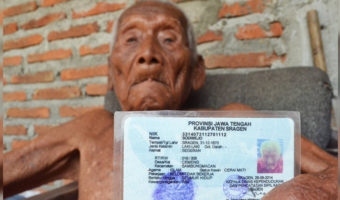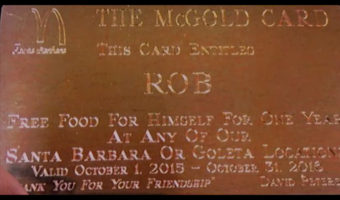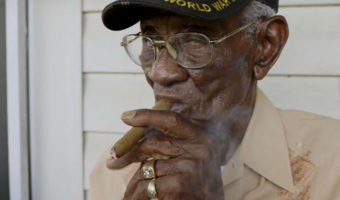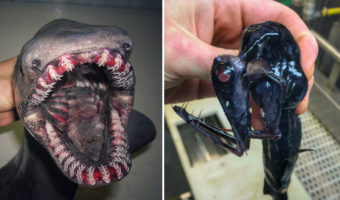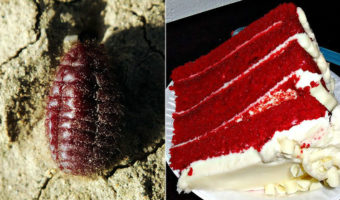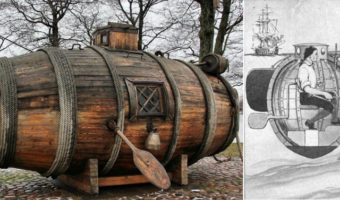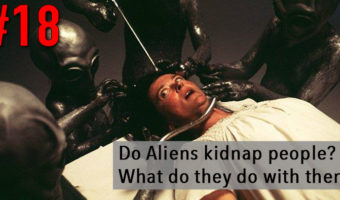20 Creepy Pictures With Their Disturbing Backstories – Part 3
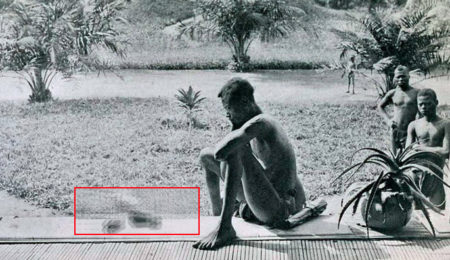
Pictures capture a moment in time before and after which a lot could have happened, and it’s all left to our imagination. They are kind of mysterious and creepy, especially when they are associated with something that defies the imagination we have in our normal everyday lives. It could be the extreme madness of one person, an atrocity committed by many, the unbearable suffering of others or the unbelievable bad luck of someone, and all of which captured in one single picture. These are the creepy pictures that would haunt you through your fears or your conscience with their disturbing backstories.
WARNING:Â GRAPHIC CONTENT, NSFW
1 A Congolese man stares at the severed hand and foot of his five-year-old daughter because he didn’t meet his daily rubber quota. She and her mother were killed and then cannibalized.
King Leopold II of Belgium had founded the Congo Free State and had ruled the Congo as a privately owned corporate state for 23 years, between 1885 and 1908. During his reign, the state became a source of great international scandals owing to the violation of human rights through forced labor. The militiamen of ABIR (Anglo-Belgian India Rubber) Company, which exploited natural rubber resources in the Congo Free State, imposed severe punishments on those who did not meet their daily rubber quota. They were required to provide the severed hands of anyone they killed or they could be accused of using ammunition, which was imported from Europe at high costs. The photograph taken by Alice Seeley Harris shows a man named Nsala whose daughter’s hand and foot were cut off, after which she was killed along with her mother. (source)
2 Picture of a shell-shocked soldier in a trench who looks like he was driven to madness after seeing the death and destruction during the WWI in 1916.

The photograph was taken during the Battle of Flers-Courcelette during the Somme Offensive in September 1916. The invention of modern weapons gave little chance to the soldiers to actually fight and have honor or a sense of fairness in death. The shell-shocked soldiers often experienced fatigue, tremors, nightmares, confusion or inability to reason, impaired sight and hearing, hysterical paralysis, and a dazed look. Back then shell shock and PTSD (Post Traumatic Stress Disorder) were not something tolerable and John Vereker, a British soldier mostly referred as Lord Gort, even proclaimed in his testimony to the Royal Commission examining the problem that prolonged shell shock was a sign of weakness and not found in good units. (source)
3 A Japanese boy carries his younger brother on the back, waiting for his brother’s turn at a funeral pyre and trying hard not to cry in September 1945, after the end of WWII.

The photograph was taken as part of an effort to document the aftermath of the air raids and atomic bombs during Second World War in Japan. According to Joe O’Donnell, the photographer, when the boy’s turn came, men in white masks came, quietly took his dead brother’s body, and placed it on fire. Biting his lower lip, he was trying hard not to burst out crying, and silently turned and walked away when the cremation was done. (source)
4 A burnt and injured baby cries among the debris of Shanghai South Railway Station after a Japanese air strike in 1937.

The Battle of Shanghai was a part of the Second Sino-Japanese War during which the Japanese military forces advanced and attacked Shanghai. The photograph named “Bloody Saturday” was taken on August 28, 1937, when the Japanese dropped bombs on Shanghai South Railway Station. According to H. S. Wong, the photographer, around 1,800 people, mostly women and children, were waiting at the station, who the Japanese had likely mistaken for a troop. The crying baby was one among many other injured or dead children. (source)
5 An unknown child’s burial after Bhopal gas tragedy, an explosion at the Union Carbide that released toxic gas killing over 2000 immediately in December 1984.

The explosion occurred on the night of December 2-3, 1984, at the Union Carbide India Limited pesticide plant releasing methyl isocyanate and other chemicals into the air. Over 500,000 people were exposed to the toxic gas, killing a total of 3,787 among which 2,259 were immediate. The two photographers, Pablo Bartholomew and Raghu Rai, who went to document the aftermath of the tragedy came across a burying ceremony where a man was burying a child. As they did not ask the man’s identity and no one claimed to be the child’s relative, her identity remains unknown. (1, 2)
6 A man and a woman with cannibalized humans during one of the Russian famines in 1921 that killed as many as 5 million.

The famines of 1921 and 22, also known as Povolzhye famine, came after six and a half years of violence and turmoil due to the First World War, the two Russian revolutions in 1917, the Russian Civil War, and even a drought. It started during the early spring of 1921 and lasted through 1922. The famine was so severe that when aid workers arrived, they found corpses strewn on the streets of Moscow and Kiev.
The situation was worse in rural regions where many people fled to cities to find work and better access to food while the rest tried to survive with whatever they could find. In one town, the government officials advised the starving residents to grind the bones of dead animals into flour and bake ersatz bread. It is not known to what extent people turned to cannibalism, but it was most common along the Volga River basin, where the famine was too severe. There were accounts of murder or euthanasia of the old or very young, who were eaten by the others. (1, 2)
7 A Buddhist monk burns himself to death to protest the Vietnamese Prime Minster Diem’s pro-catholic policies and discrimination of Buddhists in 1963.

Ngo Dinh Diem’s regime was a controversial one. In May 1963, during the Vesak celebrations, the Buddhists were prohibited from displaying Buddhist flags citing a regulation that prohibits the display of any non-governmental flags in the city of Hue, where a Catholic flag was displayed in commemoration of Diem’s elder brother’s elevation to bishop. This increased the unrest among Buddhists and civilians, and led to protests and demonstrations for freedom of religion, with many of them being killed. Thich Quang Duc immolating himself by burning himself alive to death in the middle of a busy Saigon intersection was a part of the protests. (source)
8 The photo of Soviet cosmonaut Vladimir Komarov after the Soyuz 1 space capsule parachute failed and caused him to crash into the ground. The only thing identifiable was his heel bone.

Vladimir Komarov was the first Soviet cosmonaut to have flown into outer space more than once and also the first to die on a space mission. The Soyuz mission was a complex one and he was selected to command Soyuz 1, in 1967, along with Yuri Gagarin as the backup. The first module, Soyuz 1, was to carry Komarov after which Soyuz 2 would be launched with the rest of the crew to rendezvous with the first. Then, the crew would get into the first one and Komarov would get into the second to fly it back to Earth. The mission got difficult due to the technical problems and the first module failed to fully deploy the solar panels on orbital insertion, which prevented it from powering up completely. Komarov was successfully able to reorient the module manually after a long time for re-entry and landing, but again, the parachute failed to deploy causing him to crash to the ground. (source)
9 Hisashi Ouchi received a fatal radiation dose with a mortality rate considered to be 100%. Despite desiring to die, he was kept alive in horrendous pain for 83 days against his will.

Hisashi Ouchi was one of the three workers who was preparing a small batch of fuel by adding aqueous uranyl nitrate solution to the precipitation tank. The accident occurred when they added a seventh bucket of the solution and the tank reached criticality. A self-sustaining nuclear fission reaction started and emitted gamma and neutron radiation. Ouchi, who was the nearest one, received 17 sieverts (Sv) of radiation while the permissible annual dose of radiation is considered to be 50 mSv and the fatal dose as 8 Sv. He suffered serious burns, severe internal organ damage, and had a near-zero white blood cell count. The doctors who treated them were under pressure as it was considered a matter of national dignity, and so he was kept alive despite his wishes for 83 days before his heart finally failed. (source)
10 Anneliese Michel, an epileptic, underwent a total of 67 Catholic exorcism sessions through a period of ten months and died of dehydration and malnutrition.

At sixteen, Anneliese Michel had epileptic seizures and was diagnosed with temporal lobe epilepsy. She was treated at a psychiatric hospital and was given medications for her condition. By the time she was twenty, she became convinced that the reason for her condition was being possessed by demons. As her condition worsened despite medication, her parents appealed to a Catholic priest for exorcism and received permission from a local bishop. She soon started refusing to eat and her parents, upon her request, stopped seeking medical help. During a period of ten months, in 1975-1976, 67 exorcisms were performed on her, one or two per week lasting up to four hours. She died on July 1, 1976, due to dehydration and semi-starvation for almost a year. When she died, she weighed 30 kg and had broken knees because of continuous kneeling. (source)
11 19-year-old Diana Bryant falls to her death, as the fire escape collapses, along with her 2-year-old goddaughter who survived because she landed on Bryant’s body.

On July 22, 1975, there was a fire in an apartment building on Marlborough Street in Boston. Diana Bryant and her goddaughter Tiare Jones were being rescued from almost 50 feet height by the fireman Robert O’Neill. O’Neill got onto the fire escape to help and he was moving towards the ladder when the fire escape collapsed. Bryant and Jones both fell off the fire escape. Bryant suffered multiple head and body injuries and died hours later. Jones survived as she landed on Bryant’s body which softened the impact. (source)
12 A woman being chased by young men and boys with wooden clubs during the Lviv pogroms, the 1941 massacres of Jews by Ukrainians.

Lviv pogroms were the two consecutive massacres of Jews living in the city Lwow by Ukrainian nationalists in 1941. According to Richard Breitman, a Holocaust historian, 5,000 Jews died during these pogroms and 3,000 more, mostly Jews, were executed by the Germans. Things got even worse after these pogroms. In November 1941, the Lwow Ghetto was established where 120,000 were held, most of whom were killed there or sent to Belzec extermination camp. It was so severe that the killings and deportations to Nazi concentration camps resulted in the almost complete annihilation of Jewish population locally. (source)
13 A South Vietnamese National Police Chief executes a Viet Cong captain in Saigon during the Tet Offensive in 1968.

Nguyen Ngoc Loan was South Vietnam’s chief of National Police who, on February 1, 1968, shot a handcuffed Viet Cong prisoner named Nguyen Van Lem in front of an NBC cameraman and an Associated Press photographer. The apparent cruelty in the photograph sparked anti-war movement worldwide. In addition to his military career, Loan was also an advocate for hospital construction.
Eddie Adams, the photographer, later apologized to Loan saying that photographs do lie even without manipulation and are sometimes only half-truths. He also said that “What would you do if you were the general at that time and place on that hot day, and you caught the so-called bad guy after he blew away one, two or three American soldiers?” Loan faced a lot of criticism and was forced into retirement during his later life in America from running his pizza restaurant after being publicly identified. (source)
14 Major General Horatio Gordon Robley with his collection of Mokomokai, heads of the dead people preserved by New Zealand’s Maori tribe which they traded for firearms with European sailors.

Maori are the indigenous people of New Zealand who tattooed their faces. When someone with tattoos died, their heads are preserved by sealing orifices with flax fiber and gum, then boiled or steamed in an oven, then smoked over an open fire, dried under the sun for several days, and treated with shark oil. These heads are called Mokomokai. In the early 19th century, with the arrival of Europeans, the Maori had to sell them for firearms to defend themselves. Major-General Robley, a British army officer who served in New Zealand during the 1860s, built up a collection of 35 to 40 Mokomokai which he later sold to the American Museum of Natural History. (source)
15Â The mummified body of German adventurer who vanished was found inside a drifting yacht.

The mummified body of Manfred Fritz Bajorat was discovered in his yacht, most of which was underwater, by two fishermen. He had spent around 20 years cruising the world before meeting his end. The exact cause of his death is not known though the doctors believe that he could have died of natural causes. He was found lying near the radio as if trying to call someone over the radio. Instead of being decomposed, his body was preserved probably by the dry ocean winds, hot temperatures, and salty air. (source)
16Â The Elephant’s Foot of the Chernobyl disaster, 1986
The Elephant’s Foot is a solid mass of melted nuclear fuel mixed with concrete, sand, and core sealing material that the nuclear fuel rods have melted through. The radiation emitting from it in 1986 was measured at 10,000 roentgens per hour. An exposure to it for 30 seconds would give you dizziness and fatigue within a week, 2-minute exposure would start hemorrhage, 4 minutes for vomiting, diarrhea, and fever, and 5 minutes would kill you within two days. (source)
17 The corpse of Maria Elena Milagro de Hoyos (1910–1931) encased in wax and plaster circa 1940.

Carl Tanzler, or Count Carl von Cosel, was a bacteriologist at the United States Marine Hospital in Key West, Florida. He claimed that during his childhood and later life, he had visions of a dead ancestor who revealed to him the face of an exotic dark-haired woman as his true love. On April 22, 1930, Maria Elena “Helen” Milagro de Hoyos came to him for an examination and he was convinced that she was the woman in his visions.
However, Hoyos was diagnosed with tuberculosis, which was fatal back then. Tanzler became obsessed with her and tried to cure her with a variety of medicines, even bringing X-ray and other electrical equipment to her house. He professed his love to her and showered her with gifts, jewelry, and clothing.
Nevertheless, she died on October 25, 1931, and he paid for her funeral. Then, with her family’s permission, he had a mausoleum constructed, which he visited every night. One evening, he stole her corpse, reconstructed her body by attaching the bones using wire hangers, silk cloth soaked in wax and plaster of Paris for skin, filled the insides with rags, and adorned it with clothes and jewelry believing her spirit would come to him. (source)
18 The mask worn by Edward John Louis Paisnel entitled The Beast of Jersey, a notorious sex offender who terrorized the Channel Island of Jersey for a period of eleven years from 1960 to 1971. He entered homes at night dressed in a rubber mask and nail-studded bracelets and attacked children.

Paisnel was a builder who also built his own shrine for Satan in a barn to which he would bring his victims, all young girls and boys snatched from their homes. It was revealed during the trial that he was inspired by Gilles de Rais, a notorious 15th-century occultist and child killer. He would clad himself in a woman’s black wig, a rubber mask, and a long overcoat with nail-studded lapels and shoulders, and was said to have led a Jekyll & Hyde type of existence. He was an exemplary human and took in orphan children along with his wife, but at night he would change into a murderer. (source)
19Â This photograph of a man named Brian Peppers, who was a registered sex offender in Ohio, is indeed real.

The picture is of a man named Brian Peppers when he was 34 and he was listed in Ohio’s Electronic Sex Offender Registration and Notification system due to a conviction for Gross Sexual Imposition in 1998, in Lucas County, Ohio. His appearance might have been due to either Apert Syndrome or Crouzon Syndrome. He was wheelchair-bound when the picture was taken, which explains the appearance of short stature. He was sentenced to 30 days in jail and 5-year probation for “unwilling sexual contact with one who is not one’s spouse”. (source)
20Â This photo was taken 2 weeks before the Columbine High school massacre. Look at the top left corner and you will find Eric Harris and Dylan Klebold, the students responsible for the shooting.

Before the incident, Harris and Klebold, aged 18 and 17, made home videos referring to what they were going to do and apologizing to their parents for it. On April 20, 1999, at approximately 11.29 AM, they carried bombs and guns and opened fire inside Columbine High School. They killed 13 people, twelve of them students and one teacher, and wounded 23 others. Then, they killed themselves in the school’s library at approximately 12.08 PM by shooting themselves in the head. (source)

















